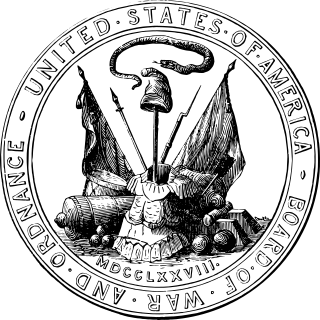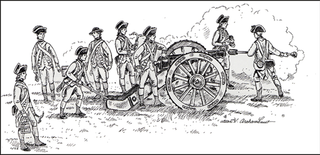
The Continental Army was the army of the United Colonies representing the Thirteen Colonies and later the United States during the American Revolutionary War. It was formed on June 14, 1775 by a resolution passed by the Second Continental Congress, meeting in Philadelphia after the war's outbreak. The Continental Army was created to coordinate military efforts of the colonies in the war against the British, who sought to maintain control over the American colonies. General George Washington was appointed commander-in-chief of the Continental Army and maintained this position throughout the war.
The 1st New Hampshire Regiment was an infantry unit that came into existence on 22 May 1775 at the beginning of the American Revolutionary War. John Stark was the regiment's first commander. The unit fought at Chelsea Creek and Bunker Hill in 1775. On 1 January 1776, while engaged in the Siege of Boston, the unit was renamed the 5th Continental Regiment. In the spring it was sent to Canada where the New Hampshire soldiers fought at Trois-Rivières and later helped defend the area around Lake Champlain. Late in the year, the 5th Continental Regiment was transferred south to George Washington's main army where it fought at Trenton.
The 3rd New Hampshire Regiment, also known as the 2nd Continental Regiment, was authorized on 22 May 1775, organized 1–8 June 1775, and adopted into the Continental Army on 14 June 1775, as the third of three regiments raised by the state of New Hampshire during the American Revolution. The enlistment dates for officers and rank and file soldiers extended to 23 April 1775, based on their response to the alarm for the Battles of Lexington and Concord.

The 2nd Canadian Regiment (1776–1783), also known as Congress' Own or Hazen's Regiment, was authorized on January 20, 1776, as an Extra Continental regiment and raised in the province of Quebec for service with the American Continental Army under the command of Colonel Moses Hazen. All or part of the regiment saw action at Staten Island, Brandywine, Germantown and the Siege of Yorktown. Most of its non-combat time was spent in and around New York City as part of the forces monitoring the British forces occupying that city. The regiment was disbanded on November 15, 1783, at West Point, New York.
The 5th North Carolina Regiment was assigned on March 26, 1776, to the Continental Army in the Southern Department. It was organized in the spring of 1776 at Wilmington, North Carolina, as eight companies of volunteers from the districts of New Bern, Edenton and Hillsborough District of North Carolina. On February 5, 1777, the regiment was assigned to the main Continental Army and assigned to the North Carolina Brigade on July 8, 1777. The regiment was reduced to a cadre on June 1, 1778, at Valley Forge, Pennsylvania and was assigned to the Southern Department. The regiment was re-organized to nine companies during the fall of 1778 at Halifax and assigned on January 11, 1779, to Sumner's Brigade. On 3 June 1779, this brigade was redesignated as Armstrong's Brigade. The regiment was captured by the British Army on 12 May 1780 at Charlestown, South Carolina and was officially disbanded on January 1, 1781.
The 8th North Carolina Regiment was authorized on November 26, 1776, and assigned to the Southern Department of the Continental Army. The 8th North Carolina Regiment played a crucial role in the Defense of Philadelphia during the Philadelphia campaign. The unit saw action at the Battle of Brandywine, Battle of Germantown and the Battle of Monmouth during the Defense of Philadelphia of the American Revolution. A part of the continental army, the Regiment was commanded by Colonel James Armstrong. The regiment was disbanded on 1 June 1778 at Valley Forge, Pennsylvania.

The Connecticut Line was a formation within the Continental Army. The term "Connecticut Line" referred to the quota of numbered infantry regiments assigned to Connecticut at various times by the Continental Congress, the size of its allocation determined by the size of its population relative to that of other states. These, together with similarly apportioned contingents from the other twelve states, formed the Continental Line. The concept was particularly important in relation to the promotion of commissioned officers. Officers of the Continental Army below the rank of brigadier general were ordinarily ineligible for promotion except in the line of their own state.

The "Maryland Line" was a formation within the Continental Army, formed and authorized by the Second Continental Congress, meeting in the "Old Pennsylvania State House" in Philadelphia, Pennsylvania in June 1775.

The Massachusetts Line was those units within the Continental Army that were assigned to Massachusetts at various times by the Continental Congress during the American Revolutionary War. These, together with similar contingents from the other twelve states, formed the Continental Line. Line regiments were assigned to a particular state, which was then financially responsible for the maintenance of the regiment. The concept of the line was also particularly important in relation to the promotion of commissioned officers. Officers of the Continental Army below the rank of brigadier general were ordinarily ineligible for promotion except in the line of their own state.

The New Hampshire Line was a formation in the Continental Army. The term "New Hampshire Line" referred to the quota of numbered infantry regiments assigned to New Hampshire at various times by the Continental Congress. These, along with similar contingents from the other twelve states, formed the Continental Line. For the promotion of senior officials, this concept is particularly important. Officers of the Continental Army below the rank of brigadier general were ordinarily ineligible for promotion except in the line of their own state.

The North Carolina Line refers to North Carolina units within the Continental Army. The term "North Carolina Line" referred to the quota of infantry regiments assigned to North Carolina at various times by the Continental Congress. These, together with similar contingents from the other twelve states, formed the Continental Line. The concept was particularly important in relation to the promotion of commissioned officers. Officers of the Continental Army below the rank of brigadier general were ordinarily ineligible for promotion except in the line of their own state.
The northern theater of the American Revolutionary War also known as the Northern Department of the Continental Army was a theater of operations during the American Revolutionary War.
1st American Regiment, also known as Jackson's Continental Regiment of 1783–1784, was the last unit in the Continental Army, retained after the close of the American Revolutionary War. This regiment, under the command of Colonel Henry Jackson of Massachusetts, was not the same unit as Jackson's Additional Continental Regiment of 1777, which had become the 16th Massachusetts Regiment in 1780 and had been disbanded in 1781. Equally, this regiment should not be confused with the First American Regiment of 1784–1791, which was originally commanded by Colonel Josiah Harmar, has remained in service to the present, and is now the 3d United States Infantry Regiment.

The 2nd Continental Artillery Regiment also known as Lamb's Continental Artillery Regiment was authorized on 1 January 1777 as Colonel John Lamb's Continental Artillery Regiment. As originally constituted, the regiment included 12 artillery companies from New York, Connecticut, and Pennsylvania. The bulk of the regiment served in the Hudson Highlands, though some companies fought with George Washington's main army from 1777 to 1779.

The 1st Continental Artillery Regiment, also known as Harrison's Continental Artillery Regiment, was authorized on 26 November 1776 as Colonel Charles Harrison's Continental Artillery Regiment. Raised for service during the American Revolutionary War, as originally organized, the regiment comprised 10 artillery companies from Virginia. Two of the artillery companies existed since early 1776. The regiment was first assigned to the Southern Department, but in March 1778 it was reassigned to General George Washington's main army. In August 1779, the unit was renamed the 1st Continental Artillery Regiment. It continued to serve with the main army until April 1780 when it was transferred to the Southern Department. In May 1780, Maryland artillery companies formally joined the regiment, making a total of 12 companies. In January 1781, the regiment was reorganized with 10 companies. Furloughed in the summer of 1783, the regiment was disbanded in November the same year. Elements of the regiment fought at Monmouth, Charleston, Camden, Hobkirk's Hill, Eutaw Springs, Yorktown, and Combahee River.
The 4th Continental Artillery Regiment, also known as Reign's Continental Artillery Regiment, was an American military unit during the American Revolutionary War. The regiment became part of the Continental Army on 10 June 1777 as Colonel Thomas Proctor's Continental Artillery Regiment. It was made up of eight artillery companies from eastern Pennsylvania. At the time of the regiment's formation, two companies were already in existence, one from as early as October 1775. One company served at Trenton in December 1776 where it performed well in action. In February 1777, Pennsylvania expanded its two-company battalion into an eight-company regiment. After officially joining the Continental Army, the regiment saw much fighting in the Philadelphia campaign in late 1777. Elements of Proctor's Regiment fought at Monmouth in June 1778 and joined the Sullivan Expedition in summer 1779.

Oliver Spencer was a New Jersey officer during the American Revolutionary War and received a special commission to enlist and lead one of 16 Additional Continental Regiments. He was born in Connecticut and later moved to New Jersey, where he married Anna Ogden and became a tanner. He joined the revolutionary cause and engaged a British force in December 1776 as a major of New Jersey militia. On 15 January 1777 during the Forage War, his militiamen captured 70 German mercenaries. That month George Washington authorized him to recruit Spencer's Additional Continental Regiment. As colonel, he led this unit at Brandywine and Germantown in 1777 and Monmouth in 1778. His regiment participated in the Sullivan Expedition in 1779 and was disbanded at the beginning of 1781. The conflict having ruined his home and his tanning business, he moved to Ohio, where he served as a probate judge and militia commander. He was the nephew of General Joseph Spencer.






